The Muzaffarid era which ruled and dominated the Shiraz art was brought to
an end by Tamerlane (Timur). Timur had established himself at Samarkand
in 1370 and for the next 35 years campaigned all over Asia, Iran, Mesopotamia,
Syria, North India and Anatolia (after the Ottomans were defeated at the
battle of Ankara in 1402). The effects of Timur (Timur was a Turk) were
different than the Mongolian invasion effect in terms of art, economics
and social systems. The paintings can be categorized as secular art.
Paintings from Kalila wa Dimna and Khamsa are depicted in this page
as well as some illustrations showing various entertainments.
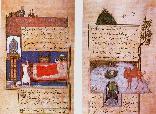
|
Left: Thief discovered in a bed chamber, Right: The perils of life
Kalila wa Dimna.
Herat, 1430.
Hazine 362, folio 24a , 27b
|
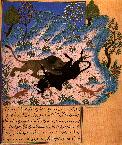
|
Lion attacking a Bull
Kalila wa Dimna.
Herat, 1430.
Revan 1022, folio 46b
|
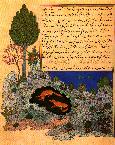
|
Kalila visits the captive Dimna
Kalila wa Dimna.
Herat, 1430.
Revan 1022, folio 56a
|
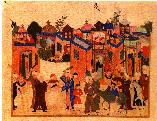
|
Genre Scene (Public punishment of three miscreants)
From the Sarai Albums
Tabriz, second half of 15th century.
Hazine 2153, folio 99b
|
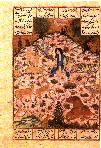
|
Majnun in the Wilderness
Khamsa.
Herat, 1447.
Hazine 786, folio 126a
|
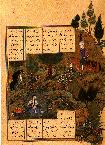
|
Khusraw surprises Shirin bathing
Khamsa.
Tabriz, 1481.
Hazine 762, folio 38b
|

|
Ferhad carries Shirin on his Shoulders
Khamsa.
Tabriz, 1481.
Hazine 762, folio 69a
|

|
Bahram Gur in the Green Pavilion
Khamsa.
Tabriz, 1481.
Hazine 762, folio 180b
|

|
Khusraw and Bahram Chubin im battle
Khamsa, by Darwish Muhammad
Tabriz, 1481.
Hazine 762, folio 51b
|
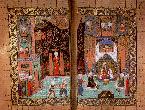
|
An entertainment at night, Sultan Husayn Mirza and his court.
Divan-i Husayni 1492.
Hazine 1636, folio 1b-2a
|
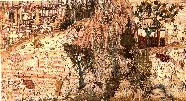
|
Workers in the Fields with a City in the Background
Page from the Sarai Albums.
Isfahan, end of the 16th century.
Hazine 2166, folio 27a
|
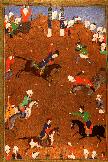
|
Polo Game
From the Sarai Albums.
Tabriz, middle of 16th century.
Hazine 2161, folio 4a
|











